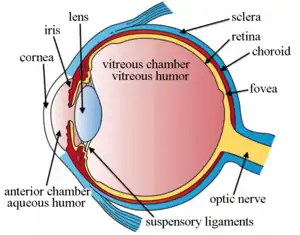Familial exudative vitreoretinopathy
Familial exudative vitreoretinopathy (FEVR, pronounced as fever) is a genetic disorder affecting the growth and development of blood vessels in the retina of the eye.[1] This disease can lead to visual impairment and sometimes complete blindness in one or both eyes. FEVR is characterized by exudative leakage and hemorrhage of the blood vessels in the retina, along with incomplete vascularization of the peripheral retina. The disease process can lead to retinal folds, tears, and detachments.
| Familial exudative vitreoretinopathy | |
|---|---|
| Other names | FEVR (initialism), Criswick-Schepens syndrome |
 | |
| Retina (located at top of diagram) | |
| Pronunciation |
|
| Specialty | Ophthalmology |
| Prevention | treatment = laser surgery |
Treatment
Currently laser surgery can be performed in order to prevent further retinal detachment. Future treatment is possible with genetically tailored medications, and ultimately with genetic modifications.
Causes
Genetic types include:
| Type | OMIM | Gene | Locus |
|---|---|---|---|
| EVR1 | 133780 | FZD4 | 11q14-q21 |
| EVR2 | 305390 | NDP | Xp11.4 |
| EVR3 | 605750 | ? (exact gene unknown) | 11p13-p12 |
| EVR4 | 601813 | LRP5 | 11q13.4 |
| EVR5 | 613310 | TSPAN12 | 7q31 |
| EVR6 | 616468 | ZNF408 | 11p11.2 |
| EVR7 | 617572 | CTNNB1 | 3p22.1 |
References
- Shastry BS (2010). "Genetic susceptibility to advanced retinopathy of prematurity (ROP)". J. Biomed. Sci. 17: 69. doi:10.1186/1423-0127-17-69. PMC 2933676. PMID 20738858.
External links
| Classification | |
|---|---|
| External resources |
- GeneReviews/NCBI/NIH/UW entry on Familial Exudative Vitreoretinopathy, Autosomal Dominant
- NCBI Genetic Testing Registry
This article is issued from Wikipedia. The text is licensed under Creative Commons - Attribution - Sharealike. Additional terms may apply for the media files.